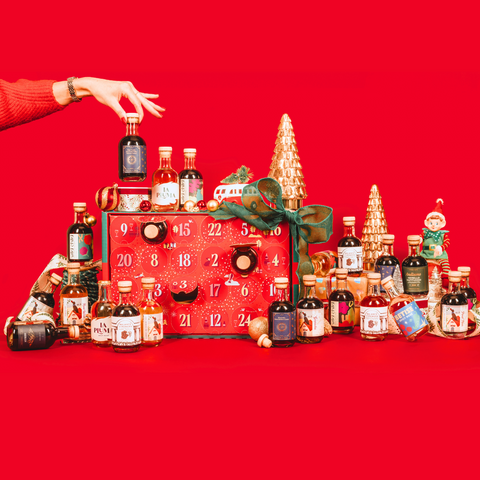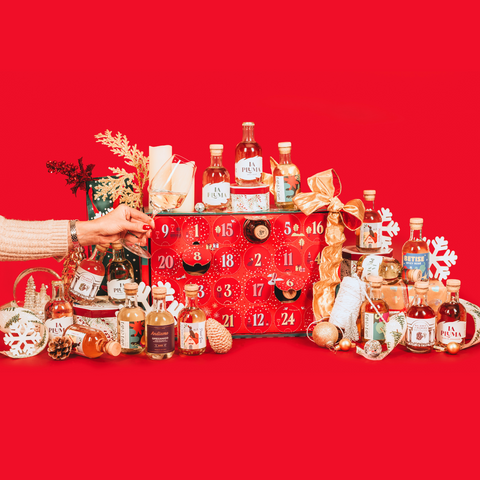Cabernet Sauvignon is a varietal born of the popular white Sauvignon Blanc and the deep red Cabernet Franc. Sauvignon, from the French word sauvage, means “wild” and perfectly describes Cabernet’s journey from the accidental result of cross-pollination to the world’s most popular red wine type.
The full-bodied Cabernet Sauvignon is beloved by both winegrowers and consumers alike. Growers love it for its sturdy, small grapes which grow well in almost any climate, as well as for its ability to stand against most diseases and insect infestations. Consumers love the dry Cabernet Sauvignon for its strong tannins and robust flavors.
Whether you try Cabernet Sauvignon as a single varietal or as part of one of the many popular red wine blends, this varietal is one every wine drinker needs to know.
A Brief History
No one could have predicted that the accidental blending of Cabernet Franc and Sauvignon Blanc that happened in France in the seventeen hundreds would result in some of the best red wines in the world. Researchers discovered the varietal’s unusual origins in 1996. By then, Cabernet had made its way into vineyards throughout Europe, South America, North America, and Australia.
At the time of its origin, French winemakers were looking for a heartier grape that was easier to grow. Cabernet was the ideal candidate. The small fruit and thick skin of Cabernet grapes allow it to thrive even in locations with less-than-ideal growing conditions. It blended well with many classic French varietals and the potent tannins responded well to aging in oak. Cabernet became especially prevalent in Bordeaux where it remains an essential component of the classic French blend to this day.
Bordeaux blends quickly expanded past the borders of French into the rest of the world. The Bordeaux region was easily accessible by ship and as their wines gained popularity, so did Cabernet Sauvignon.
Since then, Cabernet has found a foothold in many of the world’s most famous wine-growing regions including Napa Valley in California, Mendoza in Argentina, and Tuscany in Italy. Cabernet’s continued popularity stems from a combination of flavor and durability.
Growing Regions & Terroir
Cabernet Sauvignon is one of the eight noble varietals or classic grape varieties from the Old World. The best red wines made with Cabernet Sauvignon are grown in nutrient-poor, well-drained soil. The lack of nutrients and porous soil allows the plant to put more energy into the fruit and less into shoot and foliage growth. Cabernet wine grapes can also survive low temperatures and resist certain diseases. This red varietal's ability to thrive in less than ideal soil is part of what makes it such a desirable addition to any vineyard.
One of the most interesting aspects of drinking Cabernet is seeing how well the grape molds itself to the terroir of the place it is grown and comparing how well it complements the country’s unique varietals. Cabernet pairs well with many red wine grapes including the Spanish Tempranillo, Argentinian Malbec, Italian Sangiovese, and French Merlot.
FRANCE
The birthplace of Cabernet Sauvignon is still well known for its use of the grape. A quarter of the Cabernet wine grapes planted worldwide are grown in France. In Bordeaux, the hearty red varietal is mixed in varying amounts with Merlot, Cabernet Franc, Petit Verdot, Carmenere, and Malbec.
Bordeaux is where Cabernet Sauvignon gained popularity. The gravel soil deposited from the river that flows through Bordeaux is the perfect material for growing Cabernet. In good years, over 90% of the wine grapes in Bordeaux blends are Cabernet Sauvignon with small amounts of Cabernet Franc, Petit Verdot, and Merlot mixed in.
Although many winemakers in the New World have imitated this classic blend, the wines from Bordeaux remain distinct. They never lose their tannic quality, although the tannins do mellow with age, and they tend to be dry with flavors of black currant, plums, and wet soil or pencil lead.
ITALY
Tuscany is home to many of Italy’s finest wines and Cabernet plays a supporting role in one of the most popular- the Super Tuscan. Italian winemakers tend to favor native varietals over foreign ones and so Cabernet’s addition was a controversial one. However, Cabernet Sauvignon gained popularity once winemakers realized how well it complimented native varietals such as Sangiovese.
CALIFORNIA
Napa Valley gained notoriety for its Cabernet Sauvignon when the 1973 Stag’s Leap Cabernet beat out several French Bordeaux’s in a blind taste test in 1976. This stunning moment in wine history marks a turning point in Californian wine. A region that was once known for its cheap grocery store bottles was suddenly a worldwide competitor, creating wines comparable to those made by Old World producers known for making the world’s best fine wines.
Cabernet Sauvignon makes up 50% of all grapes grown in Napa Valley, although the USA only has 13% of the world’s Cabernet vines overall. Many of the greatest examples of Cabernet come from the warm and sunny Napa Valley. California Cabs can be recognized by their high acidity, high tannins, and prominent tasting notes of black cherry, green pepper, and vanilla.
WASHINGTON
Columbia Valley is the largest growing region in Washington state and Cabernet Sauvignon is the most widely planted red grape. Global warming has increased the temperature in Washington enough so that Cabernet can now be grown in the regions of Columbia Valley where the cool nights preserve acidity and the warm days give Washington Cabernet Sauvignon a plush, fruit-forward flavor profile.
Since Washington Cabernets do not enjoy the same exalted reputation as their Bordeaux and Napa Valley cousins, you can find wines of great value from these regions with flavors that rival those of much pricier bottles.
CHILE
Maipu Valley in Chile’s Valle Central is well-known for its intense and distinct Cabernet Sauvignon. One in three bottles produces in Chile is a cab sav, but some of the best bottles come from Maipu. The warm days, cool nights, and high elevation allow winemakers to create high-end bottles that compete with those from the left bank of Bordeaux and Napa Valley in California. Chilean Cabs are less fruit-forward than their California cousins, although many producers do age 1-2 years in American oak for a spice-forward flavor profile.
ARGENTINA
Mendoza produces Argentina’s best Cabernets. The South American country is famous for its steaks and Cabernet Sauvignon is the perfect complement to the salty, umami flavor of a perfectly cooked piece of beef. Cabernet also pairs well with Malbec and Bonarda, the first- and second-most-grown grapes in the country.
AUSTRALIA
From Coonawarra in the south to Margaret River in the west, Australia produces a fine bottle of Cabernet Sauvignon. The red soils of Coonawarra (called terra rossa) produce wines with notes of black fruit, chocolate mint, and cassis. Meanwhile, Margaret River produces some of the most refined Cabernet wine in Australia inspired by the classic European-style blends.
See, Taste & Smell Notes
Besides being easy to grow, Cabernet Sauvignon is known for its incredible flavor and quality. The grapes are used mostly for middle- to high-end dry red wines and typically exhibit ripe black fruit flavors with spicy, earthy notes.
Cabernet does extremely well when aged in oak. Oak tends to lighten the tannins as the wine ages and brings out complementary flavors. When it comes to aging in oak, the difference between New and Old World Cabernet Sauvignon is distinct. Old World winemakers tend to age wines for less time than those in the New World. They also tend to prefer French oak to American oak.
French oak barrels have a tighter grain which means that the flavors from them are more subtle. Old World wines often have lighter oak flavors combined with more earthy and mineral notes. A longer aging time and looser grain on American oak barrels imbibe New World wines with strong flavors of vanilla and baking spices.
One of the most distinct tasting notes for Cabernet Sauvignon is green bell pepper - a note that comes from the presence of a compound called pyrazines. While green, grassy flavors are popular in white wine, they tend to elicit a slightly mixed reaction when found in a full-bodied red.
Some critics believe green flavors in red wine are a flaw that indicates grapes picked too early in the season or the environment was too cold. Others believe that the flavor of green bell pepper should be present in any good Cabernet, as long as it’s in balance with the rest of the flavors. Like most wine-related controversies, personal preference counts for more than the opinions of the critics.
Other tasting notes to look for include:
-
Fruits: blackcurrant, blackberry, black cherries, boysenberry, blueberry
-
Savory herbs: baking spices (cinnamon, nutmeg), anise, bay leaf, green peppercorn
-
Savory non-fruit: tobacco, cedar, eucalyptus, truffle, mint, green pepper, grass, mushroom, tomato leaf, toast
-
Smoke
-
Leather
-
Toast
-
Crème de cassis
-
Chocolate
-
Graphite
Cabernet color ranges from deep ruby to dark plum. The best glass to drink Cabernet is a Bordeaux glass, which makes complete sense considering its origins. Bordeaux glasses are large and bowl-like which has several benefits when it comes to drinking full-bodied reds. First, they allow for more air to come into contact with the wine which helps wines “open up” and express subtler smells and tasting notes. Second, the bigger glass helps burn off excess ethanol vapors that may linger from fermentation. Cabernet is best served between 60-68 degrees Fahrenheit.
Acidity & Tannins
Cabernet is known for its strong tannins, rich flavor, and acidity. Depending on where the grape is grown, the wine will exhibit different levels of acidity and tannins.
For example, the cold nights in Columbia Valley in Washington make for thick skins. Thick skins mean high tannins and plenty of natural acids. Compared to Washington, the warm days and American oak used in Napa Valley give California cabs deep fruit flavors with notes of warm spices.
Pairing Notes and Recipe
The high acidity and tannins make Cabernet the perfect complement to grilled meat and flavorful sauces. When the cab sav is on the younger side, the meal should be more substantial. Think charred vegetables, bright sauces, and lots of garlic. As its ages, the tannins and acidity mellow out and so older cabs can be paired with lighter flavors.
You want to avoid pairing Cabernet Sauvignon with foods that have weak flavors and textures because you may end up with an unpleasant aftertaste from the potent acidity and strong tannins.
The acidity helps the wine cut through the fat in a nice cut of beef and the tannins give it enough body to pair well with spicy, peppery, sauces. Our suggested pairing for a Cabernet Sauvignon is a traditional ribeye with chimichurri. A nice char on the steak paired with the robust flavors of garlic, parsley, and chili is the perfect complement to this classic red wine.
Cabernet also pairs well with charcuterie, beef wellington, burgers, grilled portobello mushrooms, and cheese boards. Since Cabernet can stand up to most fatty, strong-flavored foods, a cab is a classic choice for your next holiday party.
Recipe: Grilled Ribeye with Chimmichurri and Grilled Vegetables
Everyone likes their steak cooked a certain way, although for this pairing you might want to fire up the grill. The smoky charcoal flavor on your meat is a great counterpoint to the ripe fruit, smoke, and herbal notes of your cab.
Chimichurri is a South American sauce similar to pesto but instead of basil, parsley makes up the majority of this sauce. Across South America, chimichurri is served over grilled beef or placed on the side to be enjoyed with grilled vegetables and potatoes.
This recipe makes enough for two people.
Ingredients
-
1 lb Ribeye
-
½ lb Small Potatoes
-
2 Sweet Peppers (1 Red, 1 Green)
For the chimichurri:
-
½ cup of Parsley
-
3 cloves of Garlic
-
1 Hot Pepper (optional, but encouraged)
-
2 tbsp Red Wine Vinegar
-
½ cup Olive Oil
-
½ tsp of Oregano (dried is best)
-
1 tsp of Salt
-
Pepper to taste
Directions
-
Start by tossing your potatoes in olive oil, salt, and pepper and throwing them in the oven at 350 degrees. Depending on the freshness of your potatoes, they could take anywhere from 20 to 45 min so it’s important to get them going first.
-
You may need to be flexible when cooking the ribeye. The thickness of your cut will influence how fast the ribeye cooks, as will the temperature and type of grill you cook it on. For a one-inch thick ribeye on a 400-degree grill, you would want to cook the steak for about 5 minutes on each side.
-
Many people think that a good cut of meat should always be cooked to medium-rare. That is not the case with a ribeye. You are better off cooking your ribeye to medium rather than medium-rare because at that stage the fat in the ribeye begins to render, eliminating the chewy gristle that happens when the meat is cooked to medium-rare.
-
Remove the steak from the grill and allow it to rest for 15 minutes before cutting. While the meat is resting, throw your peppers coated with a little salt and olive oil onto the grill. They should need about 2 minutes on each side.
-
Unlike pesto, you are better off not using a food processor for your chimichurri. Finely chop all of the ingredients and place them together in a bowl. It’s best to let them sit for 5-10 minutes before serving to allow all the flavors to meld together.
-
Remove the potatoes from the oven, cut the steak into nice thick strips, and serve the chimichurri over both. Chop the bell peppers into nice big chunks and you are ready to eat! Pour a nice big glass of Cabernet and enjoy.
Shopping for Cabernet Sauvignon
Cabernet Sauvignon’s popularity means it has a large production volume and a variety of pricing options. Aged Bordeaux blends from Cabernet’s country of origin are going to be on the pricier side as will those from the increasingly successful Napa Valley. But wines from Washington state, Mendoza, Maipu Valley, and Australia often combine quality with affordability.
Cabernet is a great varietal for the beginner because it’s affordable, accessible, and pairs well with a variety of meals. You can use it to taste the differences in terroir since the grape itself is the same but the growing conditions, temperature, style, and soil will be different in each place it’s grown. Compare Cabernet’s versatility at your next virtual wine tasting to see why the happy accident that occurred in France so long ago has become a favorite worldwide.









